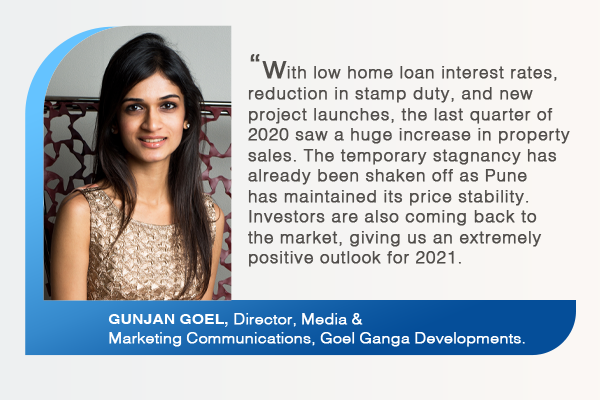Pune underwent a swift expansion after the Mumbai-Pune Expressway began functioning in 2002, establishing it as an IT hub. Today, the city’s growth continues on the backbone of key infrastructure projects like the Pune metro, which are expected to boost residential and commercial real estate by improving convenience and connectivity.
Early this year, the State government allotted Rs 30,000 Crore for various infrastructure projects including economic corridors, new roads and highways, buses, and airports.
So, how did residential real estate fare for the city?
RoofandFloor research reveals that about 1,500 properties entered Pune’s market in 2020. About 38% of this new supply was in the affordable segment (Less than Rs 40 Lakh), followed by 31% in the mid-segment (Rs 40-70 Lakh). Properties in the ultra-luxury (Rs 1 Crore and above) and luxury (Rs 70 Lakh – Rs 1 Crore) segments recorded 17% and 14% supply respectively.
“The year 2020 experienced an erratic curve in terms of sales. Different months saw different locations performing high and low. Kharadi, Bavdhan, Bibwewadi, Dhanori, Handewadi, Wakad, Viman Nagar, Mohammadwadi, NIBM, and Undri were some of the micro-markets that witnessed maximum project launches this year,” explains Gunjan Goel, Director, Media & Marketing Communications, Goel Ganga Developments.
BHK trends
With the pandemic and lockdown situation, the need for a spacious home became more imminent than before.
In 2020, 2, 3, and 3.5BHK configurations were most preferred in the city. According to Gunjan, “This year was mostly spent indoors due to the pandemic, so it created a need for the homebuyers to invest in much bigger space to be able to accommodate the whole family.”
Going forward, “We will see options like a home office being accommodated by developers in the layout, which will equip buyers to tackle any future pandemics in a much better way,” she adds.
Localities to watch out for in 2021
With the booming infrastructure and ease of business, Pune entails a huge potential for growth and investments. Dhanori, Bavdhan, Handewadi, Kharadi, Bibwewadi, Dhankawadi, Talegaon, Tathawade, Moshi, Undri, Mohammadwadi, and NIBM are expected to see new residential developments in 2021.
“Suburbs of the city are emerging rapidly due to the constant development over the years. The affordability of the properties is the key factor in these markets. Compared to other well-developed areas of the city, these localities offer much more affordability to the buyers, which in return attract more investors. Additionally, good connectivity to educational institutions and employment hubs also plays a major role,” explains Gunjan.
Infrastructure projects gain momentum
Pune metro
Earlier this year, the Pune Metro infrastructure project became the subject of many headlines in India. It had achieved the distinction of carrying out its first trial run in just 30 months becoming the fastest metro project to do so in India. The project has been carefully planned to cover the most prominent residential and commercial areas in the city. The three lines include:
- Line 1: This 16.59km line will run from PCMC Building to Swargate
- Line 2: This 14.66km line will run from Vanaz to Ramwadi
- Line 3: This 23.33km line will run from the Rajiv Gandhi Infotech Park in Hinjewadi via Balewadi to Shivajinagar.
Pune ring road
The Maharashtra government has approved a 128-kilometre ring road wrapping Pune city to keep the heavy influx of traffic from Nashik, Aurangabad, Bangalore, Hyderabad, and Mumbai at bay.
The ring road is set to make its way through 66 villages and some of the fastest-growing suburbs in and around Pune like Pimpri-Chinchwad, Mahalunge, Lonikand, and Pirangut among others.
The way forward

“Pune’s real estate market in 2021 should witness a surge in sales. With low home loan interest rates, reduction in stamp duty, and new project launches, the last quarter of 2020 saw a huge increase in property sales. The temporary stagnancy has already been shaken off as Pune has maintained its price stability. Investors are also coming back to the market, giving us an extremely positive outlook for 2021,” concludes Gunjan.

